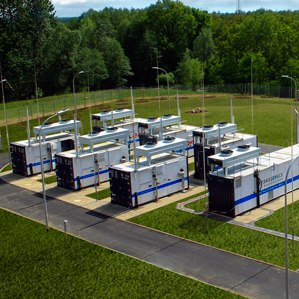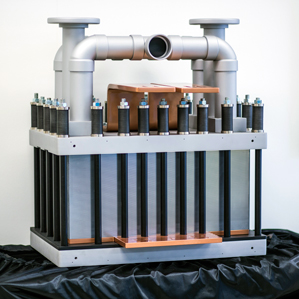Germany and Canada Are Building Water Splitters to Store Energy
Germany, which has come to rely heavily on wind and solar power in recent years, is launching more than 20 demonstration projects that involve storing energy by splitting water into hydrogen gas and oxygen. The projects could help establish whether electrolysis, as the technology is known, could address one of the biggest looming challenges for renewable energy—its intermittency.

The electrolyzer projects under construction in Germany typically consist of a few buildings, each the size of a shipping container, that consume excess renewable energy on sunny and windy days by turning it into an electric current that powers the water-splitting reaction. The resulting hydrogen can then be pumped into the storage and distribution infrastructure already used for natural gas and eventually turned back into electricity via combustion or fuel cells. It can also be used for a variety of other purposes, such as powering natural-gas vehicles, heating homes, and making fertilizer.
Germany isn’t the only country investing in hydrogen energy storage. Canada is getting in on the action, too, with a major demonstration facility planned for Ontario.
Electrolysis has advantages over some other energy storage options. It can be deployed almost anywhere, it can store vast amounts of energy, and the hydrogen can be used to replace fossil fuels not only in electricity production but also in industry and transportation, which account for far more carbon emissions.
Even so, it has long been considered a relatively lousy way to store energy because of its low efficiency—about 65 percent of the energy in the original electricity is lost. But improvements to the technology are reducing costs, and the large-scale use of renewable energy is creating new needs for storage, making electrolysis a practical option in a growing number of places.

Earlier this year, Siemens broke ground in Mainz, Germany, on what it says will be the world’s largest proton exchange membrane (PEM) electrolyzer. Whereas other electrolyzers are designed to operate with steady power levels, the PEM system performs well even with quickly changing amounts of power from wind and solar. When it opens next year, it will have the capacity to produce 650,000 kilograms of hydrogen a year, the energy equivalent of 650,000 gallons of gasoline. (As a demonstration plant, however, it probably won’t run continuously.)
Hydrogenics, which has supplied electrolyzers for many of the biggest projects in Germany, is designing a 40-megawatt system that will produce the equivalent of 4.3 million gallons of gasoline a year. The company recently developed a PEM electrolyzer that’s less than a tenth the size of its conventional alkaline ones. The small size, in addition to making it easy to site the electrolyzers, can help lower costs.
Costs are also decreasing because excess wind and solar power creates a glut of power on the grid. Because power needs to be used as soon as it’s generated to keep the grid stable, prices are sometimes dropped to zero so buyers can be found. Cheap electricity makes electrolysis far more competitive.
Electrolysis remains more expensive than producing hydrogen from natural gas—at least in the United States, where natural gas is cheap. But it can compete with storage options such as batteries, says Kevin Harrison, a senior engineer at the National Renewable Energy Laboratory in Golden, Colorado. It’s also more versatile than the cheapest way to store energy: pumping water up a hill and then letting it back down to drive a turbine. That approach is severely limited by geography—but, he says, “you can put an electrolyzer almost anywhere.”
Keep Reading
Most Popular
Large language models can do jaw-dropping things. But nobody knows exactly why.
And that's a problem. Figuring it out is one of the biggest scientific puzzles of our time and a crucial step towards controlling more powerful future models.
The problem with plug-in hybrids? Their drivers.
Plug-in hybrids are often sold as a transition to EVs, but new data from Europe shows we’re still underestimating the emissions they produce.
Google DeepMind’s new generative model makes Super Mario–like games from scratch
Genie learns how to control games by watching hours and hours of video. It could help train next-gen robots too.
How scientists traced a mysterious covid case back to six toilets
When wastewater surveillance turns into a hunt for a single infected individual, the ethics get tricky.
Stay connected
Get the latest updates from
MIT Technology Review
Discover special offers, top stories, upcoming events, and more.